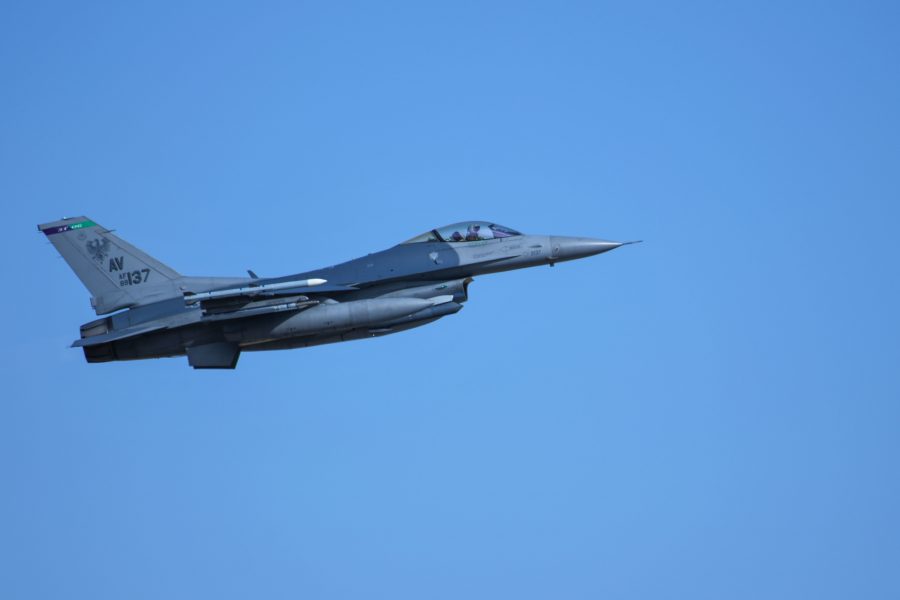The F-16 is a lightweight, multirole fighter capable of air-to-air, CAS, SEAD, interdiction, FAC-A, tactical nuclear delivery and all-weather strike missions.
The “Viper” makes up roughly half the fighter inventory, carries the majority of PGMs in service, and is one of the most maneuverable fighters ever built. The prototype YF-16 first flew Feb. 2, 1974, competing in the USAF Lightweight Fighter competition. After selection, F-16A flew on Dec. 8, 1976, followed by the two-seat F-16B on Aug. 8, 1977.

Deliveries began in August 1978, and USAF declared F-16A IOC in October 1980. F16C/D deliveries began at Block 25 in 1984, adding the APG-68 radar and AMRAAM missile as well as cockpit, airframe, and avionics improvements. Block 30/32 added the HARM missile and more powerful engines, and Block 40/42 introduced the terrain-following LANTIRN pod and wide-angle HUD for high-speed night/all-weather penetration. These airframes boasted higher take-off weight and G-limits and an expanded flight envelope starting in 1988.
Block 50/52 was introduced to replace the F-4G in the “Wild Weasel” SEAD-role armed with the HARM missile, longer-range radar, and even higher-performance engines. The F-16 entered combat during Desert Storm in 1991 and scored its first USAF air-to-air kill during Southern Watch on Dec. 27, 1992. The fleet is now cockpit-standardized with color MFD, modular mission computer, Helmet Mounted Integrated Targeting (HMIT), and Link 16. The Operational Flight Program (OFP) continuously updates the F-16’s software and most recently added JASSM-ER and enhanced AMMRAM.
Most upgrades are managed in Pre-Block (Blocks 25-32) and Post-Block (Blocks 40-52) tranches. USAF retired the final Block 25 aircraft from Luke in September 2022, and will continue retiring 76 Pre-Block aircraft through FY24. Late-block aircraft are undergoing modernization and a total of 450 are also undergoing SLEP to stretch beyond 8,000 flying hours. Modernization centers on the new AN/APG-83 AESA radar, specifically aimed at countering cruise missile threats to the homeland. An initial 72 AESA-equipped aircraft were fielded under an emergent operational need and a further 444 will be upgraded.
USAF aims to expand digital RWR upgrades into a future, fully integrated, internal EW suite for active jamming as well as self-defense. The rapidly developed Integrated Viper Electronic Warfare Suite (IVEWS) will leverage AESA and will be rapidly upgradable against new threats. An IVEWS-equipped F-16 will undergo operational assessment this year, followed by potential fleet mods starting in FY25.
Comm suite upgrades integrate Mobile User Objective System (MUOS) secure, jam-resistant BLOS and NATO-interoperable LOS SATURN, while MIDS/JTRS will provide higher capacity, jam-resistant Link 16. Other efforts include modernizing mission computer and cockpit displays in conjunction with offensive/defensive upgrades, Mode 5 IFF, navigation improvements, and Auto Ground Collision Avoidance System (AGCAS).
An F-16 tested the Legion IRST pod to passively detect and track aerial targets during a series of flights at Eglin in 2022. USAF plans to continue upgrading the F-16 to keep pace with threats through 2040 or beyond. The Wisconsin ANG’s 115th Fighter Wing and Alabama ANG 187th FW flew their final F-16 sorties in October 2022 and March 2023, respectively. Both units are transitioning to the F-35.
Contractors: Lockheed Martin (previously General Dynamics); Northrop Grumman (AESA).
First Flight: June 19, 1984 (F-16C).
Delivered: July 13, 1984-2005 (F-16C/D).
IOC: 1981 (Block 25-32); 1989 (Block 40/42); 1994 (Block 50/52).
Production: 2,206.
Inventory: 752 (F-16C); 145 (F-16D).
Operator: ACC, AETC, AFMC, PACAF, USAFE, ANG, AFRC.
Aircraft Location: Aviano AB, Italy; Edwards AFB, Calif.; Eglin AFB, Fla.; Eielson AFB, Alaska; Holloman AFB, N.M.; Homestead ARB, Fla.; Kunsan AB, South Korea; Luke AFB, Ariz.; Misawa AB, Japan; NAS JRB Fort Worth, Texas; Nellis AFB, Nev.; Osan AB, South Korea; Shaw AFB, S.C.; Spangdahlem AB, Germany; and ANG in Alabama, Arizona, Colorado, District of Columbia (flying from Maryland), Minnesota, New Jersey, Ohio, Oklahoma, South Carolina, South Dakota, Texas. Planned: Fort Wayne Arpt., Ind.
Active Variant: •F-16C/D Block 30/32. Multinational Staged Improvement Program II upgraded with new engines, flown by ANG, AFRC, and test/aggressor units. •F-16CG Block 40/42. Optimized for night/all-weather attack. •F-16CJ Block 50/52. Optimized for SEAD with long-range radar, engines, and weapons.
Dimensions: Span 32.8 ft, length 49.3 ft, height 16.7 ft.
Weight: Max T-O 37,500 lb (Block 30/32); 42,300 lb (Block 40/42); 48,000 lb (Block 50/52).
Power Plant: GE Aviation F110-GE-100, 29,000 lb thrust (Block 30); Pratt & Whitney F100-PW-220, 24,000 lb thrust (Block 32/42); F110-GE-129, 29,000 lb thrust (Block 50); F100-PW-229, 29,000 lb thrust (upgraded Block 42, Block 52).
Performance: Speed Mach 2+, ferry range 2,002+ miles.
Ceiling: 50,000 ft.
Armament: One M61A1 20 mm cannon (500 rd); up to six AIM-9 Sidewinder or AIM-120 AMRAAMs air-to-air missiles; most air-to-surface weapons in USAF inventory (nuclear and conventional) including JASSM-ER, as well as ECM and advanced targeting pods.
Accommodation: Pilot (C), two pilots (D), on ACES II zero/zero ejection seats.
